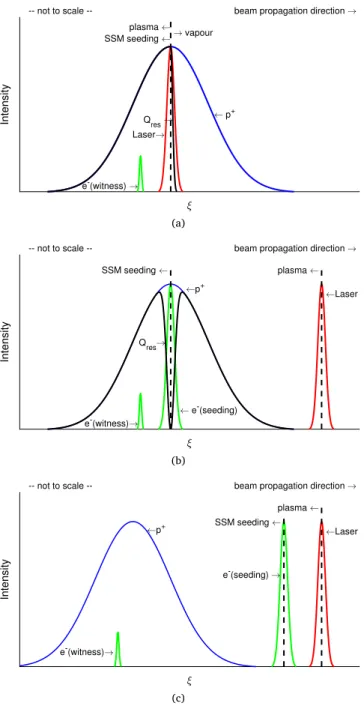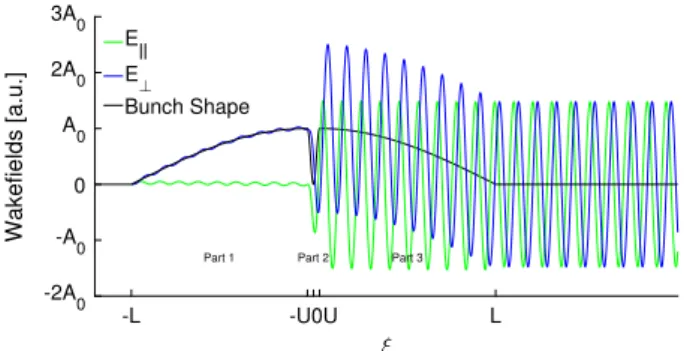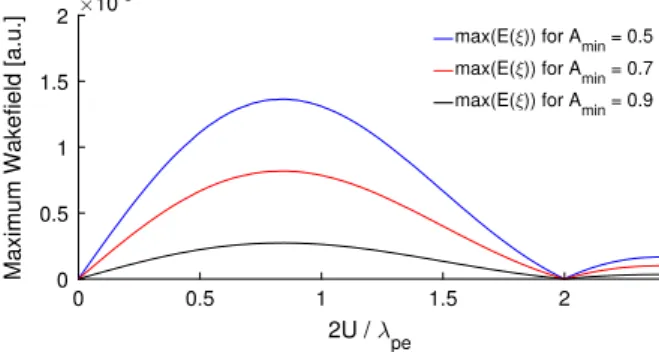Please cite this article in press as: M. Hüther, P. Muggli, Seeding of the self-modulation in a long proton bunch by charge cancellation with a short electron bunch, Nuclear Inst. and Methods in Physics Research, A (2018), https://doi.org/10.1016/j.nima.2018.02.084.
Nuclear Inst. and Methods in Physics Research, A ( ) –
Contents lists available atScienceDirect
Nuclear Inst. and Methods in Physics Research, A
journal homepage:www.elsevier.com/locate/nima
Seeding of the self-modulation in a long proton bunch by charge cancellation with a short electron bunch
Mathias Hüther
a,b,* , Patric Muggli
a,caMax Planck Institute for Physics, Munich, Germany
bTechnical University of Munich, Garching b. München, Germany
cCERN, Geneva, Switzerland
A R T I C L E I N F O
Keywords:
AWAKE
Seeding of proton bunch self-modulation Plasma wakefield acceleration Electron injection
A B S T R A C T
In plasma wakefield accelerators (e.g. AWAKE) the proton bunch self-modulation is seeded by the ionization front of a high-power laser pulse ionizing a vapour and by the resulting steep edge of the driving bunch profile inside the created plasma.
In this paper, we present calculations in 2D linear theory for a concept of a different self-modulation seeding mechanism based on electron injection. The whole proton bunch propagates through a preformed plasma and the effective beam current is modulated by the external injection of a short electron bunch at the centre of the proton beam. The resulting sharp edge in the effective beam current in the trailing part of the proton bunch is driving large wakefields that can lead to a growth of the seeded self-modulation (SSM).
Furthermore, we discuss the feasibility for applications in AWAKE Run 2.
1. Introduction
The proton bunch self-modulation in plasma wakefield accelera- tors (e.g. the Advanced Wakefield Experiment (AWAKE) located at CERN [1,2]) is usually seeded by using a high-power laser pulse co- propagating in the centre of the proton bunch (seeFig. 1(a)). The laser ionizes a vapour and creates a plasma, resulting in a sharp relativistic ionization front separating vapour and plasma. Due to this ionization front, the proton bunch self-modulation is seeded and consequently growing within a distance of a few metres before reaching its saturation level [3,4]. The long proton bunch is split into a train of micro- bunches with a period on the order of the plasma wavelength [5].
This modulation is caused by the self-modulation instability (SMI), a transverse beam–plasma instability. A witness electron bunch can thus deterministically be injected into one of the buckets between the micro- bunches and accelerated.
The seeding concept presented in this paper gives another approach to reach this goal: A high-power laser pulse is ionizing the plasma some time ahead of the proton bunch, so that the proton bunch is propagating through a preformed plasma (seeFig. 1(b)). Hence, there is no seeding from the ionization process. A short electron bunch is injected at the centre or somewhere along the long proton bunch.
The resulting local charge cancellation leads to a distinct drop in the effective charge density distribution — and is therefore driving wakefields in the rear part of the proton bunch. The front of the bunch
* Corresponding author at: Max Planck Institute for Physics, Munich, Germany.
E-mail address:huether@mpp.mpg.de(M. Hüther).
is still long with a smoothly increasing density and thus drives much lower amplitude wakefields. Thanks to the seeding process [6], the wakefield phase and amplitude is determined and weakly dependent on initial beam parameters [7]. The witness electrons to be accelerated are again injected a number of buckets behind the seeding, as in the usual injection scheme. An overview of the different self-modulation seeding approaches using a short electron bunch is given inFig. 1. A variation of the approach described in this paper, where a seed electron bunch is put ahead of the proton bunch, is shown inFig. 1(c)and will be explained later.
AWAKE is the world’s first proton-driven plasma wakefield acceler- ator aiming for acceleration of externally injected electrons in gradients up to the GV/m scale. It uses a 8–12 cm long proton bunch from CERN’s Super Proton Synchrotron (SPS) that propagates through a 10 m long Rubidium plasma (with a density of(1 − 10)⋅1014cm−3), induced by a high-power, short laser pulse (duration𝜏= 120fs, energy 𝐸= 450mJ).
2. A simplified model in linear theory
For a more quantitative understanding of the approach towards seeding, we introduce the following simplified model: The proton and electron bunch longitudinal density distribution is described by a𝑐𝑜𝑠- profile, whereas their radial profiles are Gaussian. We use 2D-linear
https://doi.org/10.1016/j.nima.2018.02.084
Received 1 December 2017; Received in revised form 9 February 2018; Accepted 19 February 2018 Available online xxxx
0168-9002/©2018 Published by Elsevier B.V.
Please cite this article in press as: M. Hüther, P. Muggli, Seeding of the self-modulation in a long proton bunch by charge cancellation with a short electron bunch, Nuclear Inst. and Methods in Physics Research, A (2018), https://doi.org/10.1016/j.nima.2018.02.084.
M. Hüther, P. Muggli Nuclear Inst. and Methods in Physics Research, A ( ) –
(a)
(b)
(c)
Fig. 1. Self-modulation seeding and electron injection schemes. (a) Current seeding concept with wakefields seeded by a vapour–plasma transition front created by a high-power laser pulse in the centre of the proton beam. (b) Novel seeding scheme with an electron bunch injected in the centre of the long proton bunch and resulting in a dip in the effective charge density. The laser pulse is ionizing the vapour ahead of the proton bunch. (c) Laser pulse and electron bunch ahead of the proton bunch. Seeding of SM process due to wakefields driven by the electron bunch.
plasma wakefield theory [8] to describe the seeding effect by calculating the initial wakefields. The total (proton and electron) longitudinal charge distribution𝑛𝑏∥(seeFig. 2) is given by
𝑛𝑏∥(𝜉′) =
⎧⎪
⎪⎪
⎪⎨
⎪⎪
⎪⎪
⎩ 𝐴0⋅sin
(𝜋⋅(𝜉′+𝐿) 2(𝐿−𝑈)
)
𝜉∈ [−𝐿,−𝑈] 𝐴𝑚𝑖𝑛−𝐴0
2 ⋅cos (𝜋𝜉′
𝑈 )
+𝐴𝑚𝑖𝑛+𝐴0
2 𝜉∈ [−𝑈 , 𝑈]
𝐴0⋅cos
(𝜋⋅(𝜉′−𝑈) 2(𝐿−𝑈)
)
𝜉∈ [𝑈 , 𝐿]
0 elsewhere,
(1)
Fig. 2. cos-approximation of the longitudinal proton bunch density 𝑛𝑏∥ as described by Eq.(1).
where𝜉=𝑐𝑡−𝑧is the spatial coordinate in the co-moving bunch frame, 2𝐿the longitudinal size of the proton bunch and2𝑈 the longitudinal size of the electron bunch. Outside[−𝐿, 𝐿]the bunch charge density is assumed to be zero. The amplitude of the proton charge density is 𝐴0 and the amplitude of the electron charge density is𝐴0−𝐴𝑚𝑖𝑛. The absolute number of charges in one bunch for our model is given by
𝑁= 8𝐴0𝐿𝑛𝑏𝜎2𝑟,𝑝⋅0.683. For comparison in case of a Gaussian longitudinal
bunch profile𝑁is given by𝑁 = (2𝜋)32𝑛𝑏𝜎𝑧,𝑝𝜎𝑟,𝑝2 . According to [8] the parallel and perpendicular wakefields𝑊𝑧(𝜉, 𝑟)and𝑊𝑟(𝜉, 𝑟)are given by 𝑊𝑧(𝜉, 𝑟) = 𝑒
𝜖0 ∫
𝜉
−∞
𝑛𝑏∥(𝜉′) cos(
𝑘𝑝𝑒(𝜉−𝜉′))
𝑑𝜉′⋅ 𝑅(𝑟) (2)
and
𝑊𝑟(𝜉, 𝑟) = 𝑒 𝑘𝑝𝑒𝜖0∫
𝜉
−∞
𝑛𝑏∥(𝜉′) sin(
𝑘𝑝𝑒(𝜉−𝜉′))
𝑑𝜉′⋅𝑑𝑅(𝑟)
𝑑𝑟 , (3)
where 𝑒 is the elementary charge, 𝜖0 the vacuum permittivity and 𝑘𝑝𝑒 =𝜔𝑝𝑒∕𝑣𝑏≈𝜔𝑝𝑒∕𝑐the plasma wave number in case of a relativistic particle bunch with bunch velocity𝑣𝑏≈𝑐. The plasma electron angular frequency𝜔𝑝𝑒is
𝜔𝑝𝑒=
√ 𝑛𝑝𝑒𝑒2
𝜖0𝑚𝑒, (4)
where𝑚𝑒is the electron mass and𝑛𝑝𝑒 the plasma charge density. The transverse component𝑅(𝑟)in Eqs.(2)and(3)is given by
𝑅(𝑟) =𝑘2𝑝𝑒𝐾0(𝑘𝑝𝑒𝑟)
∫
𝑟 0
𝑟′𝑛𝑏⟂(𝑟′)𝐼0(𝑘𝑝𝑒𝑟′)𝑑𝑟′
+𝑘2𝑝𝑒𝐼0(𝑘𝑝𝑒𝑟)
∫
∞ 𝑟
𝑟′𝑛𝑏⟂(𝑟′)𝐾0(𝑘𝑝𝑒𝑟′)𝑑𝑟′, (5) with𝐼0 and𝐾0 the modified Bessel functions of the first and second kind, respectively. Assuming the radial profile and the radial size of the electron and proton bunch are the same,𝑅(𝑟)and𝑑𝑅
𝑑𝑟 are just multiplying factors. Considering different radii is trivial.
Piecewise integration of the separate bunch parts of Eqs.(2)and(3) along𝜉 (seeFig. 2) gives the contribution of each single part to the resulting wakefields.
The wakefields driven by the leading part of the proton bunch (−𝐿 < 𝜉 <−𝑈)are described by
𝐸1,∥ (𝜉)
=
⎧⎪
⎪⎨
⎪⎪
⎩ 0
𝐴0 2𝑘𝑝𝑒
[
−(𝐶++𝐶−) [
cos
(𝜋(𝜉+𝐿) 2(𝐿−𝑈) )
+ cos(𝑘𝑝𝑒(𝜉+𝐿)) ]]
𝐴0 2𝑘𝑝𝑒
[−(𝐶+−𝐶−) sin(𝑘𝑝𝑒(𝜉+𝑈)) + (𝐶++𝐶−) cos(𝑘𝑝𝑒(𝜉+𝐿))] (6)
2
Please cite this article in press as: M. Hüther, P. Muggli, Seeding of the self-modulation in a long proton bunch by charge cancellation with a short electron bunch, Nuclear Inst. and Methods in Physics Research, A (2018), https://doi.org/10.1016/j.nima.2018.02.084.
M. Hüther, P. Muggli Nuclear Inst. and Methods in Physics Research, A ( ) –
and 𝐸1,⟂(𝜉)
=
⎧⎪
⎪⎨
⎪⎪
⎩ 0
𝐴0 2
[
(𝐶+−𝐶−) sin
(𝜋(𝜉+𝐿) 2(𝐿−𝑈) )
+ (𝐶++𝐶−) sin(
𝑘𝑝𝑒(𝜉+𝐿))]
𝐴0 2
[(𝐶+−𝐶−) cos(𝑘𝑝𝑒(𝜉+𝑈)) + (𝐶++𝐶−) sin(𝑘𝑝𝑒(𝜉+𝐿))] ,
(7)
where the first term is valid for𝜉 <−𝐿, the second term for -𝐿≤𝜉≤
−𝑈 and the third term for𝜉 > −𝑈. The parallel and perpendicular wakefields in the part where the electrons are injected and therefore cause a drop in the effective charge density are given by
𝐸2,∥(𝜉)
=
⎧⎪
⎪⎪
⎪⎪
⎨⎪
⎪⎪
⎪⎪
⎩ 0
𝐴1 2𝑘𝑝𝑒
[
(𝐷++𝐷−) sin (𝜋𝜉
𝑈 )
− (𝐷+−𝐷−) sin(𝑘𝑝𝑒(𝜉+𝑈)) ]
+ 𝐴2
𝑘2𝑝𝑒sin(𝑘𝑝𝑒(𝜉+𝑈)) 𝐴1
2𝑘𝑝𝑒
[(𝐷+−𝐷−) sin(𝑘𝑝𝑒(𝜉−𝑈)) − (𝐷+−𝐷−) sin(𝑘𝑝𝑒(𝜉+𝑈))]
− 𝐴2 𝑘2𝑝𝑒
[sin(𝑘𝑝𝑒(𝜉−𝑈)) − sin(𝑘𝑝𝑒(𝜉+𝑈))]
(8)
and 𝐸2,⟂(𝜉)
=
⎧⎪
⎪⎪
⎪⎪
⎨⎪
⎪⎪
⎪⎪
⎩ 0
𝐴1 2
[
(𝐷++𝐷−) cos (𝜋𝜉
𝑈 )
− (𝐷+−𝐷−) cos(𝑘𝑝𝑒(𝜉+𝑈)) ]
+ 𝐴2 𝑘𝑝𝑒
[1 − cos(𝑘𝑝𝑒(𝜉+𝑈))]
𝐴1 2
[(−𝐷++𝐷−) cos(𝑘𝑝𝑒(𝜉−𝑈)) + (𝐷+−𝐷−) cos(𝑘𝑝𝑒(𝜉+𝑈))]
− 𝐴2 𝑘𝑝𝑒
[cos(𝑘𝑝𝑒(𝜉+𝑈)) − cos(𝑘𝑝𝑒(𝜉−𝑈))] .
(9)
Here, the first term is valid for𝜉 <−𝑈, the second for−𝑈≤𝜉≤𝑈and the third for𝜉 > 𝑈.
The wakefields caused by bunch section between 𝑈 and 𝐿 are described by
𝐸3,∥(𝜉)
=
⎧⎪
⎪⎨
⎪⎪
⎩ 0
𝐴0 2𝑘𝑝𝑒
[
(𝐶++𝐶−) sin
(𝜋(𝜉−𝑈) 2(𝐿−𝑈) )
+ (𝐶+−𝐶−) sin(𝑘𝑝𝑒(𝜉−𝑈)) ]
𝐴0 2𝑘𝑝𝑒
[(𝐶++𝐶−) cos(𝑘𝑝𝑒(𝜉−𝐿)) + (𝐶+−𝐶−) sin(𝑘𝑝𝑒(𝜉−𝑈))] (10)
and 𝐸3,⟂(𝜉)
=
⎧⎪
⎪⎨
⎪⎪
⎩ 0
𝐴0 2
[
(𝐶+−𝐶−) cos
(𝜋(𝜉−𝑈) 2(𝐿−𝑈) )
+ (−𝐶++𝐶−) cos(𝑘𝑝𝑒(𝜉−𝑈)) ]
𝐴0 2
[(𝐶++𝐶−) sin(𝑘𝑝𝑒(𝜉−𝐿)) + (−𝐶++𝐶−) cos(𝑘𝑝𝑒(𝜉−𝑈))] .
(11)
For this case, the first line is valid for𝜉 < 𝑈, the second for the interval 𝑈≤𝜉≤𝐿and the third line for𝜉 > 𝐿.
The constants in Eqs.(6) to (11)are given by𝐴1 = 𝐴𝑚𝑖𝑛−𝐴0
2 ,𝐴2 =
𝐴𝑚𝑖𝑛+𝐴0
2 ,𝐶± = 𝜋 1
2(𝐿−𝑈)±𝑘𝑝𝑒 and𝐷±= 𝜋1 𝑈±𝑘𝑝𝑒.
Making use of the superposition theorem of waves in linear theory, the final wakefield distribution can be determined by adding the dif- ferent contributions of the bunch segments in every region. Hence, the
Fig. 3. Parallel and perpendicular wakefields𝐸∥(𝜉)and𝐸⟂(𝜉)for a bunch shape with𝜎𝑧,𝑝 = 12cm,𝜎𝑧,𝑒 = 4mm, 𝑈
𝐿 = 301, 𝑈
𝜆𝑝𝑒 = 1.6, peak currents
|𝑄𝑝+,𝑝𝑒𝑎𝑘|=|𝑄𝑒−,𝑝𝑒𝑎𝑘|.
resulting wakefields are described by 𝐸(𝜉)
=
⎧⎪
⎪⎪
⎪⎨
⎪⎪
⎪⎪
⎩
0 𝜉 <−𝐿
𝐸1(𝜉)|||𝜉∈[−𝐿;−𝑈] 𝜉∈ [−𝐿; −𝑈]
𝐸1(𝜉)|||𝜉∈[−𝑈;𝑈]+𝐸2(𝜉)|||𝜉∈[−𝑈;𝑈] 𝜉∈ [−𝑈;𝑈] 𝐸1(𝜉)|||𝜉∈[𝑈;𝐿]+𝐸2(𝜉)|||𝜉∈[𝑈;𝐿]+𝐸3(𝜉)|||𝜉∈[𝑈;𝐿] 𝜉∈ [𝑈;𝐿]
𝐸1(𝜉)|||𝜉>𝐿+𝐸2(𝜉)|||𝜉>𝐿+𝐸3(𝜉)|||𝜉>𝐿 𝜉 > 𝐿.
(12)
Fig. 3shows the longitudinal and perpendicular wakefields (Eq.(12)) for a ratio 𝑈
𝐿 = 1
30 and 𝑈
𝜆𝑝𝑒 = 1.6. The front of the proton bunch (𝜉 < −𝑈) propagates in a preformed plasma where its length is very long when compared to the plasma wavelength𝜆𝑝𝑒 and its profile is smooth. It is therefore not effective at driving wakefields, but still drives a low amplitude fields that could lead to development of the SMI process over long plasma distances. The adiabatic response of the plasma generates a globally focussing force by charge neutralization that, upon propagation, can lead to an increase in bunch density and thus also of the wakefield response. This effect could also lead to SMI growth (as opposed to SSM) over long plasma distances. From the position of the electron bunch (𝜉 > 𝑈) and all along the second half of the proton bunch, much larger wakefields are driven, which subsequently provide the strong seed for the SM process.
For bunch parameters similar to AWAKE (𝐿 = 6cm,𝑈 = 2mm,
𝑈 𝐿 = 301, 𝑈
𝜆𝑝𝑒
= 1.6, peak currents|𝑄𝑝+,𝑝𝑒𝑎𝑘|=|𝑄𝑒−,𝑝𝑒𝑎𝑘|(seeFig. 3) and 𝑘𝑝𝑒 = 5000m−1,𝑛𝑝 = 7⋅1014cm−3,𝜎𝑟= 200 μm) the wakefields in the trailing part of the bunch could reach values up to the GV/m scale.
It can be easily seen from Eqs.(6)–(11)that the amplitudes of the wakefields in the trailing part of the bunch are scaling linearly with the electron bunch charge𝑄𝑒, i.e. the depth of the gap in the effective charge density𝐴0−𝐴𝑚𝑖𝑛.
Furthermore, the wakefields are strongly depending on the width of the gap in the effective charge density 2𝑈, corresponding to the longitudinal size of the injected electron bunch𝜎𝑧,𝑒. The amplitude of the wakefields can be maximized for a given configuration of𝐴𝑚𝑖𝑛and 𝐿and follow the distribution shown inFig. 4. For an electron bunch length𝑈 on the order of𝜆𝑝𝑒, the peak wakefields are the highest (see Fig. 4).
3. Discussion of the method
The seeding method described above could be an interesting ap- proach for a seeding concept for the planned extension of the AWAKE experiment after 2021, called AWAKE Run 2 [9]. Current design studies for the plasma accelerator consist of a split plasma, a short one (∼4 m) for the seeding of the SSM and a second, longer one (∼10 m) driven by 3
Please cite this article in press as: M. Hüther, P. Muggli, Seeding of the self-modulation in a long proton bunch by charge cancellation with a short electron bunch, Nuclear Inst. and Methods in Physics Research, A (2018), https://doi.org/10.1016/j.nima.2018.02.084.
M. Hüther, P. Muggli Nuclear Inst. and Methods in Physics Research, A ( ) –
Fig. 4. Maximum wakefields for different ratios of2𝑈∕𝜆𝑝𝑒.
(a)
(b)
Fig. 5. Maximum wakefields for different ratios of2𝑈∕𝜆𝑝𝑒.
the modulated proton bunch for the acceleration of the electrons (see Fig. 5). The injection point for the witness electron bunch is foreseen to be between the two plasmas. The short plasma source is similar to the one used in AWAKE Run 1, whereas the long plasma cell could be either a Helicon or a discharge source [10].
By seeding the SMI with an electron bunch, as described here, the ionization front is not necessary for seeding and thus the first plasma could also be preformed in one of these two types of sources. Hence, there would be no longer need for a maintenance-intensive high-power laser system nor for the complicated Rubidium handling and storage procedures required by a Rubidium based vapour source.
The major uncertainty concerning the feasibility of this approach is the effect of the first part of the proton bunch. Even though, according to the simulations of Kumar et al. [5] and according to the wakefields described in Eq.(12), there is no strong seeding of the SMI expected by the leading part of the bunch, the weak amplitude wakefields or those from noise may grow. Subsequently, wakefields in the front of the bunch
would interfere with the seeded wakefields in the trailing part of the bunch. Hence, a phase-stable seeding of the SSM would no longer be possible.
First preliminary experimental results from the AWAKE-experiment show some evidence for a growth of wakefields along the bunch on a scale of a few metres as well as micro-bunching even without seeding, i.e. propagation in a preformed plasma.
In case the unseeded SM-growth in the leading part of the proton bunch is too high for a seeding with an electron bunch in the centre of the beam, another option would be to shift the electron bunch to an earlier position with respect to the proton bunch or even ahead of it (seeFig. 1(c)). With this, the full proton bunch charge could be used for driving wakefields, while removing the risk of growth of SMI ahead of the seeding point.
4. Conclusions
We presented an alternative concept for the seeding of the SSM in plasma-wakefield accelerators. Instead of seeding by an ionization front created by a high-power laser pulse, the seeding is archived by the injection of a short electron bunch in the centre of a long proton bunch propagating through a preformed plasma. Calculations in 2D linear theory show that the resulting steep rising edge in the effective charge density of the proton bunch drives large amplitude wakefields that seed the SSM. Although the approach is very promising and could simplify the design for AWAKE Run 2, first experimental results from the latest AWAKE Runs give evidence that wakefields do grow from noise in the front of the proton bunch, when the bunch propagates in a preformed plasma and no seeding is provided.
References
[1] P. Muggli, et al., Physics of the AWAKE project, in: IPAC 2013: Proceedings of the 4th International Particle Accelerator Conference, 2013, pp. 1179–1181.
[2] E. Gschwendtner, et al., AWAKE, the advanced proton driven plasma wakefield acceleration experiment at CERN, Nucl. Instrum. Methods Phys. Res. A 829 (2016) 76–82.
[3] K.V. Lotov, A.P. Sosedkin, A.V. Petrenko, Long-term evolution of broken wakefields in finite-radius plasmas, Phys. Rev. Lett. 112 (2014) 194801.http://dx.doi.org/10.
1103/PhysRevLett.112.194801.
[4] A. Caldwell, et al., Path to AWAKE: Evolution of the concept, Nucl. Instrum. Methods Phys. Res. A 829 (2016) 3–16.
[5] N. Kumar, A. Pukhov, K. Lotov, Self-modulation instability of a long proton bunch in plasmas, Phys. Rev. Lett. 104 (25) (2010) 255003.
[6] K. Lotov, et al., Natural noise and external wakefield seeding in a proton-driven plasma accelerator, Phys. Rev. ST Accel. Beams 16 (4) (2013) 041301.
[7] N. Savard, P. Muggli, J. Vieira, Effect of proton bunch parameter variation on awake, in: North American Particle Accelerator Conf., NAPAC’16, Chicago, IL, USA, October 9–14, 2016, JACOW, Geneva, Switzerland, 2017, pp. 684–686.
[8] P. Chen, et al., Plasma focusing for high-energy beams, IEEE Trans. Plasma Sci. 15 (2) (1987) 218–225.
[9] E. Adli, Towards AWAKE applications: Electron beam acceleration in a proton driven plasma wake, in: 7th Int. Particle Accelerator Conf., IPAC’16, Busan, Korea, May 8–13, 2016, JACOW, Geneva, Switzerland, 2016, pp. 2557–2560.
[10] AWAKE Collaboration, AWAKE status report 2016, SPSC-SR-194.
4


